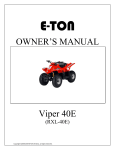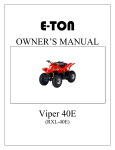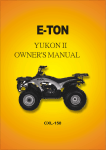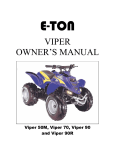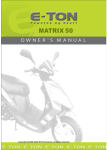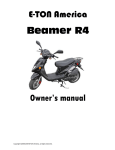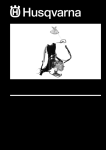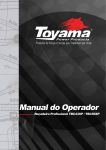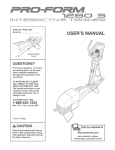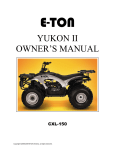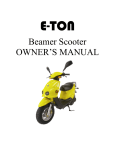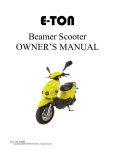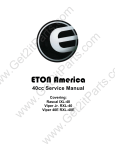Download E-TON Viper Jr. (RXL-40) Owner`s manual
Transcript
E-TON OWNER’S MANUAL Viper Jr. (RXL-40) Copyright ©2008-2009 ETON America, all rights reserved. Copyright ©2008-2009 ETON America, all rights reserved. Important Notices READ and UNDERSTAND this owner’s manual Both the operator and the adult supervisor should completely read and understand this owner’s manual before operating this vehicle. This owner’s manual will instruct you in the safe operation of the vehicle. NO Passengers This vehicle was designed for operation ONLY by the operator, (Driver). The load limit and seat configuration is designed for the operator ONLY. It is not safe to carry passengers on the vehicle. ADULT Supervision and Instruction are REQUIRED. This vehicle MUST NOT be operated by a youth without Adult supervision and instructions. Unattended operation without adult supervision could result in injuries. E-TON recommends that both the operator and the adult supervisor attend an ATV safety instruction course. ALWAYS Wear Protective Clothing While operating this vehicle, the driver must always wear protective clothing. Protective helmet with face shield, elbow and knee pads, long leg pants, gloves and hard soled boots should always be worn when operating this vehicle. OFF ROAD Use ONLY This vehicle is designed and manufactured for off-road use only. Operation on public streets, roads or highways is illegal and very dangerous. OBEY all State and local laws and regulations Each state and local governing agency has laws and regulations for ATV operations. It is the owner’s responsibility to know, understand and obey these laws and regulations. SPEED RESTRICTION Devices This vehicle is equipped with electronic speed limiting devices. Any attempt to change, over-ride or bypass these devices may cause dangerous operating conditions. Copyright ©2008-2009 ETON America, all rights reserved. Page 1 Table of Contents Safety notes Vehicle identification number location Controls, switches and feature locations Control feature operations Engine stop switch Remote Stop Switch Throttle lever Rear Brakes Parking brake Safety Tether Switch Fuel System Fuel tank Fuel valve Inline Fuel Filter Engine Oil Tires & Wheels Tire inspection Tire pressure Spark Plug Air Filter Braking Systems Drive Chain Throttle Lever Transmission Oil ATV Break-In Procedure Pre-Operation Inspection Starting procedure Driving Turning Parking 10 10 10 10 11 11 12 13 13 13 14 15 15 15 Specifications Maintenance Schedule Wiring Diagram Manufacture’s Warranty Owner’s notes 15 17 18 19 21 Copyright ©2008-2009 ETON America, all rights reserved. Page 2 3 6 6 7 7 7 8 8 8 8 9 9 10 Safety Notes 1. Both the adult supervisor and youth operator must fully understand everything in this manual before operating this vehicle. 2. This vehicle was designed for the operator only. NO PASSENGERS should be allowed on this vehicle. 3. This vehicle is designed for operation on level, obstacle free off-road areas. 4. Riding this vehicle on public roads or highways is illegal. If it becomes necessary to cross a public road or highway, the vehicle should be pushed across using extreme caution. 5. This vehicle MUST NOT be operated without adult supervision and instruction. 6. DO NOT operate this vehicle while under the influence of drugs, alcohol or other medication that impairs judgment or coordination. Doing so can result in serious injury or even death. 7. Maintain a safe distance between your vehicle and other vehicles with whom you are riding. 8. READ the owner’s manual carefully before riding. 9. ALWAYS wear a helmet, face shield, elbow & knee pads, hard-soled boots, gloves, and protective clothing while operating this vehicle. Copyright ©2008-2009 ETON America, all rights reserved. Page 3 10. NEVER ride this vehicle unless it has been properly maintained and adjusted. Always perform a pre-ride inspection of your vehicle. Look for wires, bolts and other fasteners that may have come loose on previous rides. Inspect the drive chain, throttle and brakes for proper adjustment and operation. Check the engine oil level in the oil tank. Check fuel level and inspect for fuel leaks. (Remember, you can ride further in 1 hour than you can walk back in 1 day!) 11. WARM UP your body with some exercises before riding. This helps to make you alert and prevent cramping and other discomfort. 12. LEARN TO RIDE this vehicle properly and safely. Have an experienced rider teach you the safe operation of your vehicle. E-TON recommends you take an ATV riding course before you first ride your vehicle. Copyright ©2008-2009 ETON America, all rights reserved. Page 4 13. NEVER REFUEL this vehicle when hot. Ask your adult supervisor to refuel your vehicle. Gasoline is extremely flammable and will ignite if spilled on a hot engine or muffler. Never smoke or expose the fuel to an open flame or spark while refueling your vehicle. Always refuel your vehicle in a safe place free of any ignition source. 14. NEVER run the vehicle in an enclosed area. The exhaust gases from the engine contain CARBON MONOXIDE which can be fatal if breathed in high concentrations for an extended time. 15. HOT! The engine and exhaust system on your vehicle become very hot during normal operation. Touching these hot surfaces can cause severe burns. Always assume that your unit’s engine and exhaust system are HOT unless you know that they are not. Copyright ©2008-2009 ETON America, all rights reserved. Page 5 Vehicle Identification Numbers Vehicle Identification Number (VIN) is located at the front of the unit under the front fender on a plate mounted between the main frame rails. Engine serial number is located on the left-hand side of the engine on the crankcase housing. Your VIN RFZ______________ Eng. No. _______________ Controls, Switches & Feature Locations Locations of controls and features 1. Fuel Tank filler and vent tube 2. Fuel Valve 3. Throttle lever 4. Rear/Parking brake lever 5. Engine stop switch 6. Safety Tether switch 7. Pull Starter Copyright ©2008-2009 ETON America, all rights reserved. Page 6 Control feature operations Engine Stop Switch The remote switch has two buttons, a Stop button which will stop the engine when pressed. The effective range of the switch is 30 feet unobstructed. Once the unit has been stopped with the remote switch you must press the run button in order for the unit to be restarted. This action resets the remote receiver on the unit. Safety Note: Always test the remote switch The stop switch is a red colored rocker switch located on the left-hand handle bar. before beginning a riding session. The remote switch is operated by a battery which should be replaced once a year. You can obtain a replacement battery at your local department store. To start and run the engine, this switch must be placed in the on, “O”, position. The vehicle is also equipped with a safety brake switch which will prevent the engine from starting until the parking brake is engaged. To stop your engine, place the switch to the stop, “X”, position. In the stop, “X”, position the ignition system is grounded preventing the spark plug from firing. This switch can also be used as a safety or emergency stop switch. Throttle lever The throttle lever is located on the right-hand handle bar below the grip. To operate the throttle lever, place your right thumb on the lever and press forward to increase your speed. To decrease your speed, reduce your pressure on the lever and the spring tension will automatically reduce your speed. The travel of the throttle lever is controlled by the throttle stop bolt. Remote Stop Switch The Viper Jr. comes equipped with a remote Stopt key ring switch. Copyright ©2008-2009 ETON America, all rights reserved. As your operator gains more experience, you can increase the throttle travel to allow for additional speed to be obtained. To increase the throttle’s travel, thus increasing the maximum speed, turn the throttle stop bolt Page 7 counter clockwise. To decrease the throttle’s travel, thus decreasing the maximum speed, turn the throttle stop bolt clockwise. The throttle cable should be adjusted so there is 2mm, (1/8”) free travel at the lever before the throttle starts to open. Rear Brakes This vehicle is equipped with a mechanical drum rear brake that is both the running brakes and the parking brake. Safety Tether Switch The Viper Jr. model is equipped with a safety tether switch. It is located on at the rear of the vehicle under the rear fender. The switch cap must be fully engaged for the vehicle to run. The cap is tied to a tether that can be worn by the ride or control by a supervising adult. The vehicle engine can be stopped by pulling on the tether until the switch cap becomes disengaged. This action will stop the engine. Fuel Tank The fuel tank fill cap is located on top of the unit just ahead of the seat. The cap contains a vent to prevent a vacuum from forming in the tank as fuel is used. The vent tube must be attached to the cap and inserted in the vent tube holder hole of the handle bar cover while operating the unit. The fuel cap vent and vent tube must be clean and clear of obstructions for the unit to operate normally. You can check the vent and vent tube by blowing air through the tube. If you can not The brake is controlled by the long brake lever on the left-handle bar. The rear brake is the primary stopping brake on your vehicle. Using the rear brake to stop your vehicle will prevent steering control loss. Parking Brake The rear brake lever has a button located at the pivot point to lock the brake in the, “O”, on position. This should be engaged as a parking brake whenever the vehicle is not in operation. This feature should be engaged in order to start the engine. The brake lever has a safety switch built in to prevent the engine from starting while the brake is disengaged. If your engine fails to start, ensure that the engine stop switch is in the on, “O”, position and that the parking brake is engaged. Copyright ©2008-2009 ETON America, all rights reserved. blow through the vent tube and cap you must clean the vent and tube or replace them. Every time you refuel your unit, check the rubber seal inside the cap for cuts, tears and dirt. Clean or replace the seal if it becomes worn or torn. The seal must be in good condition to insure a proper seal of the cap to the tank to prevent fuel spills. DO NOT allow dirt or other debris to enter the tank when refueling. Replace the cap if damaged or if it will not seal to the tank. Page 8 Tighten the cap snugly, being careful not to over tighten. Over tightening the cap can cause damage to the cap or seal. The fuel tank capacity is 4.5 liters, 1.2 gal, including a reserve of 0.8 liters, 0.2 gal. When you have to switch to the “RES” position you must refuel the unit as soon as possible. ALWAYS CHECK YOUR Fuel level before you start riding your ATV. Remember: You can drive further in one hour on your ATV than you can walk in one day. Use unleaded automobile gasoline with an octane level of 91 or higher. NEVER REFUEL YOUR ATV when the engine is HOT. Wait 30 minutes after turning off the unit before refueling. Spilling fuel on a HOT engine could cause a fire. Wipe up any fuel spills before re-starting. Inline Fuel Filter Your ATV is equipped with an inline fuel filter to prevent dirt and debris from entering the carburetor and engine. Fuel Valve The unit is equipped with a three way fuel valve located on the left side of the unit just below the seat. The valve has three settings; “OFF”, “ON” and “RES”. With the valve in the “OFF” position Check the filter for dirt or damage before each ride and at each refueling. Replace the filter if dirty or damaged. The filter should be replaced every 600 hours of operation and at the start of each season. fuel is held in the tank and is prevented from flowing to the carburetor. The valve should be placed in the “OFF” position whenever the unit is not being operated. Place the valve in the “ON” position for normal operation of the unit. This allows fuel to flow to the carburetor for normal operating. The “RES” position allows fuel to flow from the small reserve in the tank to allow the unit to be taken to a refueling location. Copyright ©2008-2009 ETON America, all rights reserved. To replace the filter, first turn the fuel valve to the “OFF” position. Then carefully compress the wire clamp rings until the clamp is free of the fuel line. Slide each clamp away from the filter about ¾”. Remove the filter from the fuel line by holding the line and pulling the filter. Install the new filter by inserting the filter into the fuel line and returning the clamps to the original position. Turn the fuel valve to the “ON” position and check for leaks. Inspect the fuel lines for cuts, abrasions and deterioration. Replace fuel lines as needed. DO NOT start or operate the engine if the fuel filter or lines are leaking. Leaking fuel can cause a fire. Page 9 Engine Oil 2 Cycle Engine Your ATV uses 2 cycle oil to lubricate the engine. The oil is mix with the fuel prior to refueling the unit. Use a synthetic 2 cycle oil and mix at a 50:1 ratio with the fuel. (About 2.5oz to a gallon) Never run the engine with straight fuel as sever engine damage will occur requiring the engine to have to be rebuilt or replaced. Tires and Wheels Tire & Wheel inspection It is important to inspect your tires and wheels for damage and wear before each riding Check your tire pressure before each riding session and at each refueling operation. Always check the pressure when the tires are cool. Use the tire pressure gauge that came with your ATV to check the tire pressure. Tire Pressure Recommended tire pressure is: 7psi Maximum (Hot after riding) 2psi Minimum (Cold before riding) Wheel Nut torque 24-30 N/m (18-22 lb/ft) Spark Plug Replace spark plug at the beginning of each season with a replacement plug NGK BPM6Y/NGK Disconnect spark plug wire. Clean dirt from around spark plug base with brush or air. Remove spark plug with spark plug wrench. Set the spark plug gap on the new plug to 0.023” Install the new by plug screwing it in finger tight and then use the plug wrench to screw the plug in another ½ turn. Inspect the spark plug wire for cuts, nicks or other damage. Replace as needed. Air Filter session. Inspect each tire for cuts, tears and punctures. Inspect the wheel rim for dents and separation of the wheel from the tire bead. Replace any tire or wheel found to be damaged. Operating your ATV with damaged tires or wheels is dangerous. Damaged tires or wheels can result in a sudden loss of tire pressure and control which could result in injuries. Copyright ©2008-2009 ETON America, all rights reserved. Air Filter Maintenance To maintain the highest performance from your engine and to reduce excessive wear that could cause engine failure, the engine requires a continuous flow of clean air. Air is taken into the engine through an air filter to clean the air prior to mixing it with fuel and oil in the carburetor. During normal operation the filter accumulates dirt from the air and will need to be cleaned to maintain the proper air flow. The filter should be cleaned every 30 days, more often if you ride in a dusty or dirty environment and the element should be replaced every year. The air filter box is located on the left side of the engine. To access the air filter you must remove Page 10 the left side engine shield. The cover is about 3x4” box and is attached to the crankcase with two bolts To clean the filter Remove the air filter box cover. Remove the filter element from the air box. Clean the screen located in the mounting box behind the element. Rear Brake System Inspection Visually inspect the brake cable for any signs of wear, kinking, corrosion or other damage. Test the brake by applying pressure to the brake lever and trying to push the unit forward. If the wheel rotates while the brake is applied, check your brake cable, brake adjustment and brake pads. If the brake lever feels hard to squeeze the brake cable may need to be lubricated or may be damaged. Lubricate the cable with a cable lubricant available from your dealership. When the brake is fully applied there should be a Wash the element in a non-flammable solvent such as Air-Filter cleaner from your local auto parts dealer. 1. Dry the element completely before continuing. 2. Soak the element in clean engine oil until completely saturated. 3. Squeeze out the excess oil until the element does not drip any oil. 4. Allow the element to dry then reinstall the element and cover. minimum clearance of ½” of clearance between the lever and the handle bar grip. If this clearance is less that ½” your brakes should be adjusted After riding your unit, be sure to clean any build up of mud, sand and dirt from the brake cable and adjuster to prevent rust and corrosion that could cause cable failure. Braking Systems Your ATV unit is equipped with a rear mechanical drum brake. The rear brake is applied by squeezing the brake lever on the left-handle bar. Proper maintenance of the brake system is a necessary part of safe operation of your unit. The brake systems should be inspected and tested before each riding session. Copyright ©2008-2009 ETON America, all rights reserved. Drive Chain The drive chain will stretch with use and will require periodic adjustments. To check the chain tension, remove the chain guard and measure the slack. The amount of slack in the chain should not exceed 10-20mm or ¼” - ½”. Page 11 Inspect the drive and axle sprockets for worn, damaged or broken teeth. Replace as needed. Inspect the chain links for damaged, worn or loose rivets. Repair or replace as needed. Throttle Lever The throttle lever is located beside the righthandlebar grip and is operated by using the righthand thumb. The lever is spring loaded and will return to the idle position when you remove your Chain Slack Adjustment thumb from the lever. To accelerate the unit, simply Loosen the axle position lock bolt slightly and turn press the lever forward to open the throttle slide in the chain adjuster nut to take up the excess slack the carburetor. To slow the unit, reduce the pressure in the chain. Once the chain has been adjusted on the lever or remove your thumb and the throttle to the proper tension retighten the axle position will return to the idle position automatically. locking bolt. The chain should be kept well lubricated to prevent excess wear and premature failure. We recommend that you lubricate the chain every 15 hours of operation, or more frequently if needed, with a high quality chain lubricant. Adjusting the throttle The cable should be adjusted to allow for ⅛” free travel before the throttle engages the carburetor throttle slide. To adjust the cable’s free travel, loosen the locking nut of the cable adjuster, and turn the adjuster wheel until there is ⅛” free travel in the lever. Tighten the locking nut to secure the adjusting ring. The speed of the unit can be adjusted by adjusting the throttle stop screw to limit throttle travel. Loosen the throttle stop screw locking nut and turn the throttle stop screw clockwise to reduce the Copyright ©2008-2009 ETON America, all rights reserved. Page 12 throttle travel thus reducing the maximum speed of the unit. Turning the stop screw counter clockwise will increase the throttle travel thus increasing the maximum speed of the unit. Tighten the stop screw locking nut when the desired throttle travel has been established. NOTE: Your unit includes an electronic speed control that is set to limit the maximum speed of the unit to the standards set by the CPSC for the age of the rider for which the unit was designed for. Changing Transmission Oil ATV Break-In procedures Your ATV requires a break-In period just as with all other internal combustion engines. This period allows the engine parts to seat and wear properly without undue strain which can cause premature failure. 1. For the first two weeks of operation do not run your ATV at full throttle for extended periods of time. 2. You should only fill the fuel tank with a premix of fuel and synthetic 2cycle oil at a 50:1 ratio (Approximately 2.5oz of oil per each gallon of fuel). Use unleaded fuel only with an octane rating of at least 89. 3. Do not operate the unit at more than 85% of maximum speed. 4. Do not over rev the engine. 5. Use light braking pressure to allow the brake shoes to seat to the drum. Pre-Operation Inspection procedure 1. Place an oil catch pan under the unit directly below the transmission box. 2. Remove the transmission box drain plug located on the bottom of the transmission box on the underside of the unit. 3. Remove the transmission box fill hole plug locate on top of the transmission box near the oil tank bracket on the left hand side of the unit. 4. Allow the oil to drain completely (15-30 min). 5. Reinstall the drain plug and tighten. Torque to 7-10lbf-ft 6. Fill the transmission box with 70cc of SAE 80-90 gear oil. 7. Reinstall the fill hole plug finger tight. 8. Dispose of used oil at a proper recycling station as required by law. Copyright ©2008-2009 ETON America, all rights reserved. The following procedure must be performed before each operating session. Checking your ATV takes only a few minutes and may save you from serious injuries and costly repairs. 1. Check engine fuel level. 2. Check brake & brake cable operations. 3. Check tire condition and pressure. 4. Check drive chain condition and slack. 5. Check throttle operation and free play adjustment. 6. Check engine stop switch for proper operation. 7. Check steering system. Look for free and smooth operation. Check all fastening hardware. 8. Check all nuts, bolts and other fasteners for loose conditions. 9. Inspect unit for any broken or damaged parts. 10. Check all indictor lights and switches for proper operation. Page 13 11. Test remote Stop switch for proper operation. 12. Test safety tether switch for proper operation. 13. Insure you are wearing proper clothing and protective gear. Helmet, Gloves Pads etc. Starting Procedure The following procedure must be followed each time you start your unit. Park the unit on a level surface and lock the parking brake. 1. Turn the fuel valve to the “ON” position. 2. Turn the engine stop switch to the “ON” position. Driving your ATV Your ATV should only be driven in an area that is designated for this use. Insure that the area is free of obstacles and other dangers that could cause a loss of control. Check with your local authorities for any regulations regarding the use of your ATV. Always keep your feet on the footrests and your hands on the handle bar grips while operating your ATV. Doing so will give you the best control of the unit. Start your ATV by following the starting procedure above and allow the engine a few minutes to warm up before releasing the parking brake. Start the unit by slowly increasing the throttle until the unit begins moving. Turning your ATV Learning to turn your ATV requires you to learn to shift your weight and control the throttle to allow the rear wheels to turn properly. When making a turn, the wheels on the outside of the turn must travel a wider radius and thus a greater distance than the inside wheels of the turn. Since the rear axle does not permit a different rate of rotation, it is not enough to merely steer your ATV into the turn. 3. Set the carburetor choke to closed, “ON”, position by pushing the choke lever up fully. 4. Apply slight pressure to the throttle lever. 5. Pull the starter handle sharply on the left-handle bar. Your unit should start within 1 or 2 pulls of the starter handle. If the unit fails to start check the following. 1. Engine stop switch is “ON”. 2. Parking Brake Locked “ON”. 3. Tether switch is fully inserted. 4. If you used the remote switch to stop the unit you must press the run button to reset the receiver stop switch. Copyright ©2008-2009 ETON America, all rights reserved. To turn properly, steer in the direction of the turn and lean your body to the inside of the turn while supporting your weight on the outer footrest. Use the throttle to maintain power throughout the turn. If you do not use this turning technique the unit will have a tendency to continue in a straight line. If this occurs, release the throttle lever to allow the unit to stop. Avoid braking or accelerating until you have regained directional control. Page 14 3. Set the engine stop switch to “OFF” position. 4. Engage the parking brake locking button. 5. Turn the fuel valve to the “OFF” position. 6. Remove the ignition key to prevent unauthorized use or theft of your ATV. Parking Your ATV 1. Always park your ATV on a level surface. 2. Turn the ignition key to the “OFF’” position to stop the engine. 2004 Viper Jr. RXL-40 Specifications Viper Jr. (RXL-40) Engine Type Displacement Bore / Stroke Compression Power Two cycle air cooled pre mix fuel/oil 41.5cc φ40.0 * 33.0mm 6.6 : 1 2.2ps @ 7000rpm Transmission Type Single Speed Centrifugal Clutch Chassis Overall Length Overall Width Overall High Wheel Base Dry Weight 1120mm / 44.0" 630mm / 24.8" 727mm / 28.6" 768mm / 30.2" 64kg / 134lbs Suspension Front Rear A-Arms Dual Shocks Swing Arm / Single Shock Brakes Front Rear N/.A Mechanical Drum Tires Front Rear Front Tire Pressure Rear Min Max Min Max 145/70-6 145/70-6 2psi / 0.14kg/cm2 (Cold) 7psi / 0.49kg/cm2 (Cold) 2psi / 0.14kg/cm2 (Cold) 7psi / 0.49kg/cm2 (Cold) Wheels Bolt Pattern Direct attach Carburetor Make/Size Main Jet Pilot Jet Idle Speed HC 16mm (Manual Coke) 64mm 18mm Idle 2500rpm Copyright ©2008-2009 ETON America, all rights reserved. Page 15 Sprockets Front Rear Chain 14 teeth 36 teeth #420 Battery N/A Fluids Fuel Engine Oil Transmission Type Volume Type Unleaded Gasoline 89 octane 3.5 liters / 0.9 gal High grade synthetic 2 cycle oil Volume Type Volume Pre Mix 50 : 1 SAE 80/90 weight 70cc / 2.4oz Spark Plug NGK Nipendenso Champion Electrode Gap Maximum Rider Weight Minimum Rider Age BPM6Y/NGK W22MP-U CJ7Y (Not Recommended) 0.6-0.7mm / 0.023" 36.3kg / 80lbs 6 years Copyright ©2008-2009 ETON America, all rights reserved. Page 16 Maintenance Schedule First week Every 30 Days Every Year I Fuel Lines Throttle Operation Air Filter Fuel Filter Spark Plug Drive Chain Brake Shoes Brake System Bolts, Nuts & Fasteners Wheels I I C I, L R R R I I, L I I I I I I I I Inspect as part of pre-ride inspection I Steering system Every 6 months Suspension System Transmission Oil Choke Spark Arrester Battery Notes Replace Fuel & Vent Lines every 2 years Inspect as part of pre-ride inspection Inspect as part of pre-ride inspection Inspect as part of pre-ride inspection Inspect as part of pre-ride inspection I R or 100 hrs I C every 100 hrs R every 200 Hours I, C I = Inspect, Clean, Adjust, Lubricate or Replace as needed C= Clean L = Lubricate R = Replace Owners Maintenance Records Maintenance Preformed Copyright ©2008-2009 ETON America, all rights reserved. Date Page 17 Preformed By Copyright ©2008-2009 ETON America, all rights reserved. Page 18 ETON AMERICA, LLC. LIMITED VEHICLE WARRANTY ETON America warrants all new ETON vehicles sold by authorized Eton Dealers to be free from defects in materials and workmanship, subject to the following exclusions and limitations. New vehicles sold by an authorized dealer to original retail consumers are covered by this policy for a period of six (6) months from the date of delivery. There is no mileage limitation. Vehicles used in rental service or for certain commercial purposes are specifically excluded from this policy. (Check with your dealer for warranty application.) Items and conditions that are specifically excluded from this warranty program are; 1. Damage caused by accidents, misuse, negligence, improper vehicle operation. 2. Any modification or alteration to any standard specifications or equipment. 3. Any repairs made by an unauthorized dealer or service firm. 4. Use of non-ETON genuine parts for repairs or alteration to standard specifications. 5. Damage caused by failure to perform factory scheduled service maintenance. 6. Damage which occurs as a result of improper storage. 7. Damage caused by the use of improper fuel or lubricants, and/or failure to use proper oil/gas mixture on two stroke models. The following normal wear parts are specifically excluded from warranty coverage: 1. Rubber parts 2. Tires 3. Belts 4. Brake linings 5. Normal wear item 6. Brake parts 7. Cables 8. Filters 9. Spark plugs 10. Bulbs 11. Batteries 12. Sprockets 13. External springs 14. Seat and hand grips. Copyright ©2008-2009 ETON America, all rights reserved. Page 19 ETON AMERICA, LLC. LIMITED VEHICLE WARRANTY Scheduled maintenance service is the responsibility of the owner during and after the warranty period. In the event of a failure or required repair, the owner should take vehicle to an authorized dealer for repair without undue delay and within a maximum of thirty, (30), days of the occurrence of the problem. All eligible warranty repairs must be made at any authorized dealer’s normal place of business. Any transportation costs, or other expenses which may occur in order to obtain warranty service, are the responsibility of the owner. All eligible repairs covered under this warranty will be paid to the servicing dealer only, by ETON America, and no additional payments shall be made for authorized warranty repairs. Dealer and/or ETON America are not responsible for loss of use, other damage or inconvenience due to warranty repairs. It is the customer/buyer’s responsibility to review with the selling dealer the pre-delivery service schedule to assure machine is properly serviced prior to delivery acceptance. It is recommended that the buyer take a test ride to familiarize themselves with the machine and to make certain the unit is in proper operating condition. The dealer is responsible for checking and performing all items on the “set-up and pre-delivery checklist” prior to delivery to the customer. This warranty is valid at any authorized ETON Dealer in the United States only. In the event you experience any problem obtaining prompt service, contact ETON America, customer service department for assistance. Always consult first with your selling dealer and/or service personnel for assistance with any service work or repairs. In the event you have a problem obtaining service send your name, address, and vehicle identification number to Eton America for assistance. The above stated policy is the only policy offered and backed by ETON America, and no other organization or individual is authorized to make or offer any different arrangements. Some states prohibit certain limitations or conditions or do not allow exclusions or limitations. You may be eligible for additional consideration, so check with your local dealer or appropriate state agency for assistance. Rights vary from state to state, and you may have other rights not offered in this warranty. ETON America warrants all new vehicles comply with applicable US regulations. Copyright ©2008-2009 ETON America, all rights reserved. Page 20 Owner’s Notes: Copyright ©2008-2009 ETON America, all rights reserved. Page 21 Copyright ©2008-2009 ETON America, all rights reserved. Page 22
























